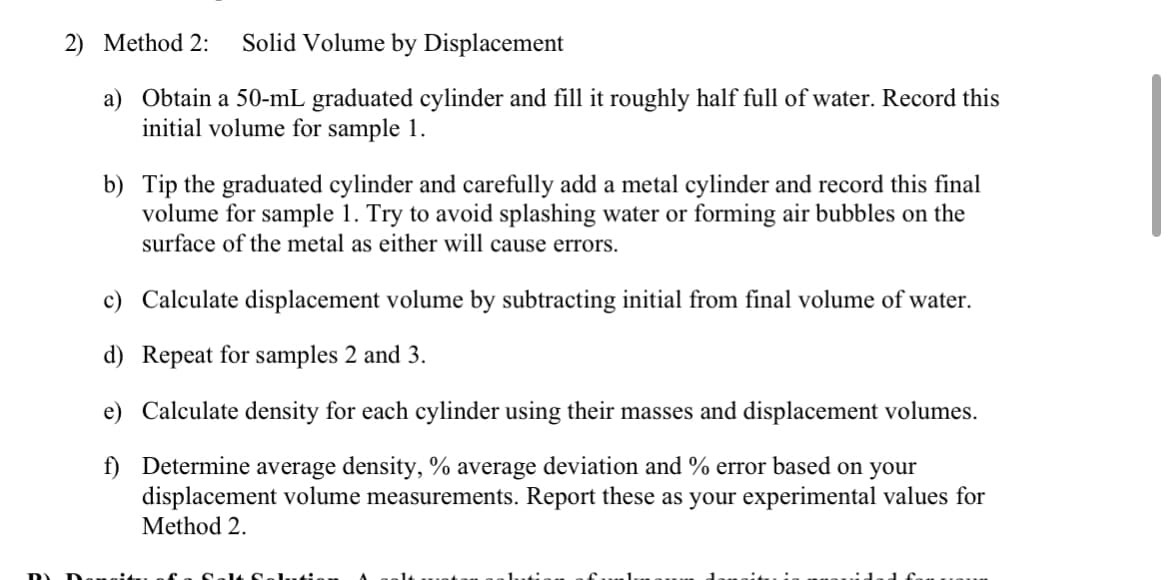Principles of Modern Chemistry
8th Edition
ISBN:9781305079113
Author:David W. Oxtoby, H. Pat Gillis, Laurie J. Butler
Publisher:David W. Oxtoby, H. Pat Gillis, Laurie J. Butler
ChapterA: Scientific Notation And Experimental Error
Section: Chapter Questions
Problem 8P
Related questions
Question

Transcribed Image Text:5) How will each of the following experimental errors influence the results of your calculated
densities you reported? State whether the error will tend to make your density results too
large, too small or unchanged. Explain why this would occur by identifying which
measurements would be affected (high or low) and how this would affect the calculated
density.
a) In method 2, the metal cylinder you used had a number of air bubbles on its when
immersed in the water.

Transcribed Image Text:2) Method 2:
Solid Volume by Displacement
a) Obtain a 50-mL graduated cylinder and fill it roughly half full of water. Record this
initial volume for sample 1.
b) Tip the graduated cylinder and carefully add a metal cylinder and record this final
volume for sample 1. Try to avoid splashing water or forming air bubbles on the
surface of the metal as either will cause errors.
c) Calculate displacement volume by subtracting initial from final volume of water.
d) Repeat for samples 2 and 3.
e) Calculate density for each cylinder using their masses and displacement volumes.
f) Determine average density, % average deviation and % error based on your
displacement volume measurements. Report these as your experimental values for
Method 2.
Expert Solution
This question has been solved!
Explore an expertly crafted, step-by-step solution for a thorough understanding of key concepts.
Step by step
Solved in 5 steps

Knowledge Booster
Learn more about
Need a deep-dive on the concept behind this application? Look no further. Learn more about this topic, chemistry and related others by exploring similar questions and additional content below.Recommended textbooks for you

Principles of Modern Chemistry
Chemistry
ISBN:
9781305079113
Author:
David W. Oxtoby, H. Pat Gillis, Laurie J. Butler
Publisher:
Cengage Learning

Chemistry & Chemical Reactivity
Chemistry
ISBN:
9781337399074
Author:
John C. Kotz, Paul M. Treichel, John Townsend, David Treichel
Publisher:
Cengage Learning


Principles of Modern Chemistry
Chemistry
ISBN:
9781305079113
Author:
David W. Oxtoby, H. Pat Gillis, Laurie J. Butler
Publisher:
Cengage Learning

Chemistry & Chemical Reactivity
Chemistry
ISBN:
9781337399074
Author:
John C. Kotz, Paul M. Treichel, John Townsend, David Treichel
Publisher:
Cengage Learning


Introductory Chemistry: An Active Learning Approa…
Chemistry
ISBN:
9781305079250
Author:
Mark S. Cracolice, Ed Peters
Publisher:
Cengage Learning

Chemistry & Chemical Reactivity
Chemistry
ISBN:
9781133949640
Author:
John C. Kotz, Paul M. Treichel, John Townsend, David Treichel
Publisher:
Cengage Learning